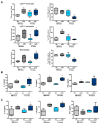Identification of Adipose Tissue as a Reservoir of Macrophages after Acute Myocardial Infarction
- PMID: 36142416
- PMCID: PMC9499676
- DOI: 10.3390/ijms231810498
Identification of Adipose Tissue as a Reservoir of Macrophages after Acute Myocardial Infarction
Abstract
Medullary and extra-medullary hematopoiesis has been shown to govern inflammatory cell infiltration and subsequently cardiac remodeling and function after acute myocardial infarction (MI). Emerging evidence positions adipose tissue (AT) as an alternative source of immune cell production. We, therefore, hypothesized that AT could act as a reservoir of inflammatory cells that participate in cardiac homeostasis after MI. To reveal the distinct role of inflammatory cells derived from AT or bone marrow (BM), chimeric mice were generated using standard repopulation assays. We showed that AMI increased the number of AT-derived macrophages in the cardiac tissue. These macrophages exhibit pro-inflammatory characteristics and their specific depletion improved cardiac function as well as decreased infarct size and interstitial fibrosis. We then reasoned that the alteration of AT-immune compartment in type 2 diabetes could, thus, contribute to defects in cardiac remodeling. However, in these conditions, myeloid cells recruited in the infarcted heart mainly originate from the BM, and AT was no longer used as a myeloid cell reservoir. Altogether, we showed here that a subpopulation of cardiac inflammatory macrophages emerges from myeloid cells of AT origin and plays a detrimental role in cardiac remodeling and function after MI. Diabetes abrogates the ability of AT-derived myeloid cells to populate the infarcted heart.
Keywords: adipose tissue; diabetes; macrophages; myocardial infarction.
Conflict of interest statement
The authors declare no conflict of interest.
Figures







References
-
- Rabiller L., Robert V., Arlat A., Labit E., Ousset M., Salon M., Coste A., Costa-Fernandes D., Monsarrat P., Ségui B., et al. Driving regeneration, instead of healing, in adult mammals: The decisive role of resident macrophages through efferocytosis. NPJ Regen. Med. 2021;6:1–12. doi: 10.1038/s41536-021-00151-1. - DOI - PMC - PubMed
MeSH terms
Grants and funding
LinkOut - more resources
Full Text Sources
Medical
Molecular Biology Databases

